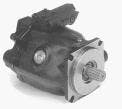P1 medium-pressure, variable displacement, axial-piston pumps suit pressures to 4060 psi. Compact, round housing is quieter than other designs, offering continuous service at high drive speeds. Three models have maximum displacements of 4.58, 6.41, and 8.85 in. 3 /rev and choice of SAE and ISO mounting flanges and ports, end or side inlet and outlet ports, and case drain ports for horizontal, vertical, or shaft-up mounting.
Parker Hannifin Corp., Hydraulic Pump Div., (800) 551-5956, www.parker.com



